
Sam Hallas' Website
A Short History of Telegraphy - 1 Beginnings
By Alan G. Hobbs (G8GOJ) and Sam Hallas (G8EXV)
It is well nigh impossible to describe the entire history of the electric telegraph in a few pages, but I hope we can still give you an insight into
the ingenuity and technology of the early inventors - the pioneers who laid the foundations for today’s complex, computer based systems.
Click the images for a larger version. Click 'Close' or press ESC to return. Main text is the original 1987 article
New text is shown in italics I have added a supplement, Part 4, to summarize the changes I have seen in telegraphy since the article was written up to 2014.
The Dawn of Time
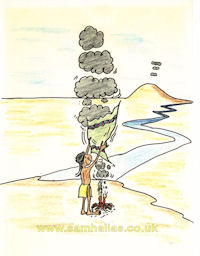
Since earliest times human beings have wanted to communicate at a distance.
Primitive Man could keep hunting parties in touch about the movement of
game by means of smoke signals. Military man was able to co-ordinate his
armies. The ancient Greeks used mirrors to reflect the sun’s rays at the
battle of Thermopylae.
All sorts of ways have been found of passing messages and they all rely
on extending the human senses of sight or hearing in some way.
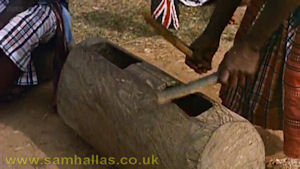 The explorer and journalist, Stanley, - famous for having found Dr Livingstone
- when he was travelling the Congo river (now the River Zaire), was mystified
to find that the villagers knew he was coming in advance. Of course the
answer to the mystery was the talking drum. The drum is made from a tree
trunk, hollowed out and shaped. Depending on how you hit it, different
notes are produced which can sound like the local language. A means of
communicating ideally suited to a country with dense forest, where one
cannot see from one village to the next. Another very apt name for the
drums is the ‘Jungle Telegraph’. [Picture & video: Pathé 'Look at Life']
The explorer and journalist, Stanley, - famous for having found Dr Livingstone
- when he was travelling the Congo river (now the River Zaire), was mystified
to find that the villagers knew he was coming in advance. Of course the
answer to the mystery was the talking drum. The drum is made from a tree
trunk, hollowed out and shaped. Depending on how you hit it, different
notes are produced which can sound like the local language. A means of
communicating ideally suited to a country with dense forest, where one
cannot see from one village to the next. Another very apt name for the
drums is the ‘Jungle Telegraph’. [Picture & video: Pathé 'Look at Life']
Video of talking drum at half speed
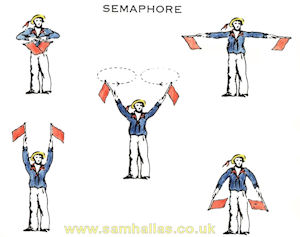
Conversely, one place where one can see for miles is at sea. And navies
have used flags and semaphore for centuries. Using it on land is more difficult.
To signal as far as possible some high vantage points are needed - even
better if you can put it on a tower.
Mechanical Telegraphs
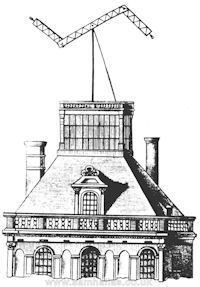
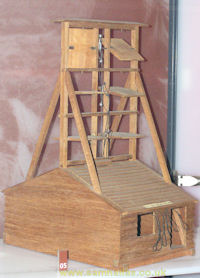
Just such a system was invented in the 1790s by Frenchman Claude Chappe
- a system of wooden shutters on a tower, which could show 63 different
signals. [Correction: The Chappe system used a pair of semaphore arms as illustrated left.] Naturally, military leaders quickly grasped the importance of systems like this and Napoleon made good use of the Chappe telegraph in
his invasion of Italy. A system was made linking London to the naval dockyards
at Portsmouth. Needless to say, fog or bad weather frequently interrupted
communication. [Picture: Public domain via Wikimedia commons]
[Watch this YouTube video of Prof Nigel Linge demonstrating a Chappe telegraph replica]
Addendum: The British military telegraph described above would have looked like this model on the right in the National Museum of Scotland.
Definition
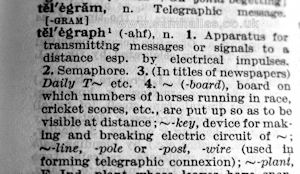
These semaphore type systems were the first to be described as a telegraph.
Telegraph was a word coined in 1792 from the Greek, tele, afar, and graphos,
a writer. Concise Oxford Dictionary
First Steps with Electricity
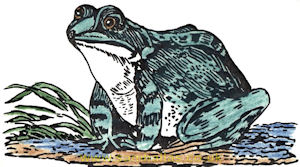
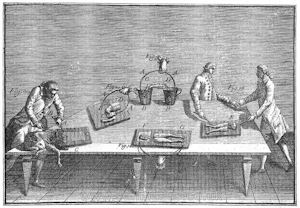 But electricity was on its way to assist the art of telegraphy. In the
second half of the 18th Century there were important discoveries about
the nature of electricity though it remained a mysterious fluid. Galvani
conducted experiments with frogs’ legs to show the effects of electricity.
Volta developed a battery, giving a steady source. Other experiments showed
that transmission along wires was virtually instantaneous. This held out
tantalising prospects for telegraphy. The first problem was to detect the
presence of an electric current. [Picture: Frog, BT; Galvani, Public Domain]
But electricity was on its way to assist the art of telegraphy. In the
second half of the 18th Century there were important discoveries about
the nature of electricity though it remained a mysterious fluid. Galvani
conducted experiments with frogs’ legs to show the effects of electricity.
Volta developed a battery, giving a steady source. Other experiments showed
that transmission along wires was virtually instantaneous. This held out
tantalising prospects for telegraphy. The first problem was to detect the
presence of an electric current. [Picture: Frog, BT; Galvani, Public Domain]
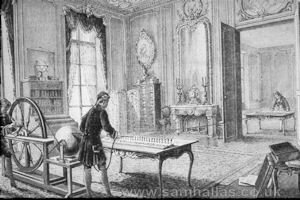
Lesage’s telegraph used pith ball electrometers and another early idea
from S.T. van Soemmering was to use the electrolysis of water to detect
the current. But an important breakthrough came in 1810 when Ampere and
Oersted showed that the current in a wire could deflect a magnetised needle.
By 1836 a needle telegraph had been developed by Baron Pawel Schilling.
This was seen by the young William Cooke. [Picture: Science Museum collection]
The Cooke & Wheatstone Era
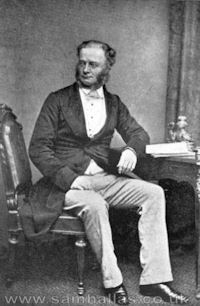
William Fothergill Cooke
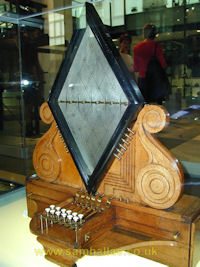
Cooke immediately saw the possibilities of a telegraphic system linking
the major towns in the country. But he was unknown to investors. So to
get commercial support for his scheme he turned to Professor Charles Wheatstone
as partner. It was in 1837 that Cooke & Wheatstone devised the first
practical telegraph, which was known as the five needle system. This was
an alphabetical system with five needles, controlled by five separate wires. More detailed information at the
Science Museum, London
[Picture of Cooke: Public Domain] (The 5-needle instrument in the Science Museum, London, on the right is a replica made for museum display, probably, in the 1930s. Collector Fons Vanden Berghen has an identical one shown here. And here he is demonstrating it.)
The needles pointed to to the desired letter. It only remained for the
receiving operator to note down the letters in order as received.
[Watch this YouTube video of Prof Nigel Linge talking about and demonstrating a 5-needle replica, or a more recent, excellent demonstration and explanation by Wim der Kinderen here]
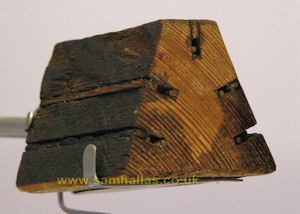
Section of 5-needle cable
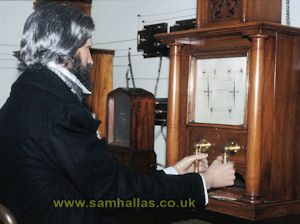
2-needle telegraph
The five needle system was clumsy to operate and, because it needed five wires,
was expensive to cable. It was not long before it was replaced by the double
needle system, with only two wires, using a code to indicate the letters.
The first telegraphs were the Railway Companies’ private systems, but the
double needle telegraph was the first to be used for a public telegraph
from Paddington to Slough in 1841.
Morse Code Begins

Samuel Finley Breese Morse
In turn the double needle gave way to the single needle system, using
only one wire and the famous code developed by the Americans, Samuel Finley
Breese Morse and Alfred Vail. A further development, the Highton single needle system,
introduced in 1837 employed the Morse code, transmitted from a device known
as a commutator. The commutator had two keys, which made current flow in
opposite directions in the line, corresponding to a dot and a dash. The single-needle telegraph was widely used on British railways for communications between signalboxes. See my single-needle article
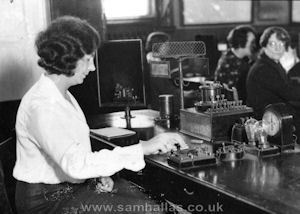
Morse operators at the Central Telegraph Office
Originally, the receiving operator had to watch the needle and write down
the letters. This made it very slow, and pretty soon means were found to
make the signal audible to the operator. By putting two different type
of stop pins, two distinctive sounds were made - a sort of ‘ting’ and ‘tong’.
The operator now had only to concentrate on listening to the sounds, and
write down the letters. (Once again Fons Vanden Berghen is able to demonstrate one from his collection
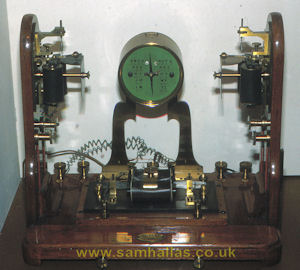
Single needle & double-plate sounder
Experience soon showed that a skilled operator could interpret Morse
code from the long and short periods of the dots and dashes. As a result
the familiar single current Morse key and sounder came into use. This is
the first data transmission system which is still in extensive use today
on the amateur bands. [Morse operators picture: Science Museum/ HPL] (Notice that the Morse sounder on the operator's left is mounted in a wooden box to amplify the sound.
Easy as ABC with Wheatstone
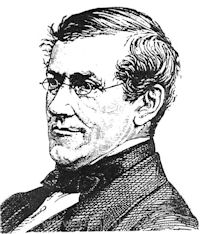
Charles Wheatstone
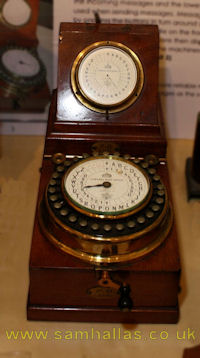
To get away from the need for highly trained operators, Sir Charles
Wheatstone invented the ABC system in 1840. It indicates the letter directly
by a pointer, like a clock hand. There is a hand generator on the front,
a dial with 30 keys round the edge and a pointer. The whole thing was known
as a communicator. A separate receiver also had a single pointer.
To work it one pressed the key for the letter wanted and wound the generator.
The pointer would go round until it reached the key pressed and then it
disconnected the generator. Pressing another key then allowed the pointer
to rotate to the next letter and so on.
The generator sent alternating half cycles of current to the line and
the receiving pointer moved round a letter at a time, like a stepper motor,
till it reached the letter being sent.
It was pretty simple, robust, and needed little skill to operate. Speeds
were up to about 15 words per minute.
See one in action in the Scottish Islands in the 1930s from The Islanders (PO Film Unit) in the clip below, left. On the right Richard Youl (YouTube ID tressteleg1) demonstrates a Wheatstone ABC machine in the Telstra Museum in Sydney, Australia. Can you see what message he sends?
ABC telegraph in use on a Scottish Island in the 1930s
ABC telegraph at Telstra Museum, Sydney
These articles copyright 1987-2014, AG Hobbs & SM Hallas.
Back to Top
Part 2
Part 3
Part 4 - Supplement
Telecomms Index
 The explorer and journalist, Stanley, - famous for having found Dr Livingstone
- when he was travelling the Congo river (now the River Zaire), was mystified
to find that the villagers knew he was coming in advance. Of course the
answer to the mystery was the talking drum. The drum is made from a tree
trunk, hollowed out and shaped. Depending on how you hit it, different
notes are produced which can sound like the local language. A means of
communicating ideally suited to a country with dense forest, where one
cannot see from one village to the next. Another very apt name for the
drums is the ‘Jungle Telegraph’. [Picture & video: Pathé 'Look at Life']
The explorer and journalist, Stanley, - famous for having found Dr Livingstone
- when he was travelling the Congo river (now the River Zaire), was mystified
to find that the villagers knew he was coming in advance. Of course the
answer to the mystery was the talking drum. The drum is made from a tree
trunk, hollowed out and shaped. Depending on how you hit it, different
notes are produced which can sound like the local language. A means of
communicating ideally suited to a country with dense forest, where one
cannot see from one village to the next. Another very apt name for the
drums is the ‘Jungle Telegraph’. [Picture & video: Pathé 'Look at Life']

















